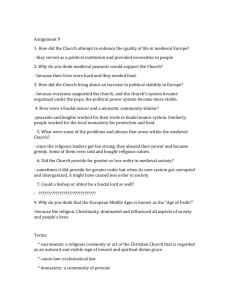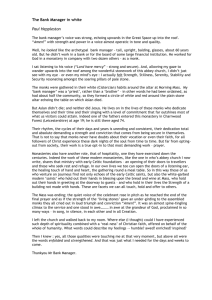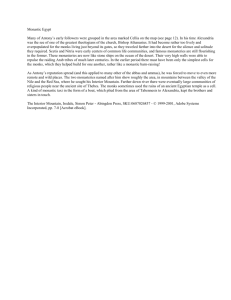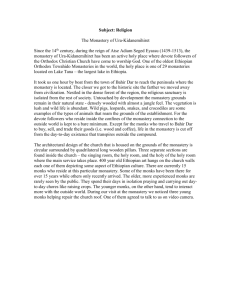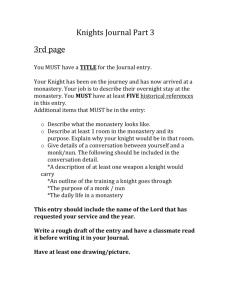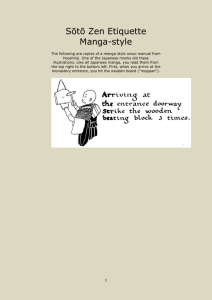Life in a Medieval Monastery - MCI
advertisement
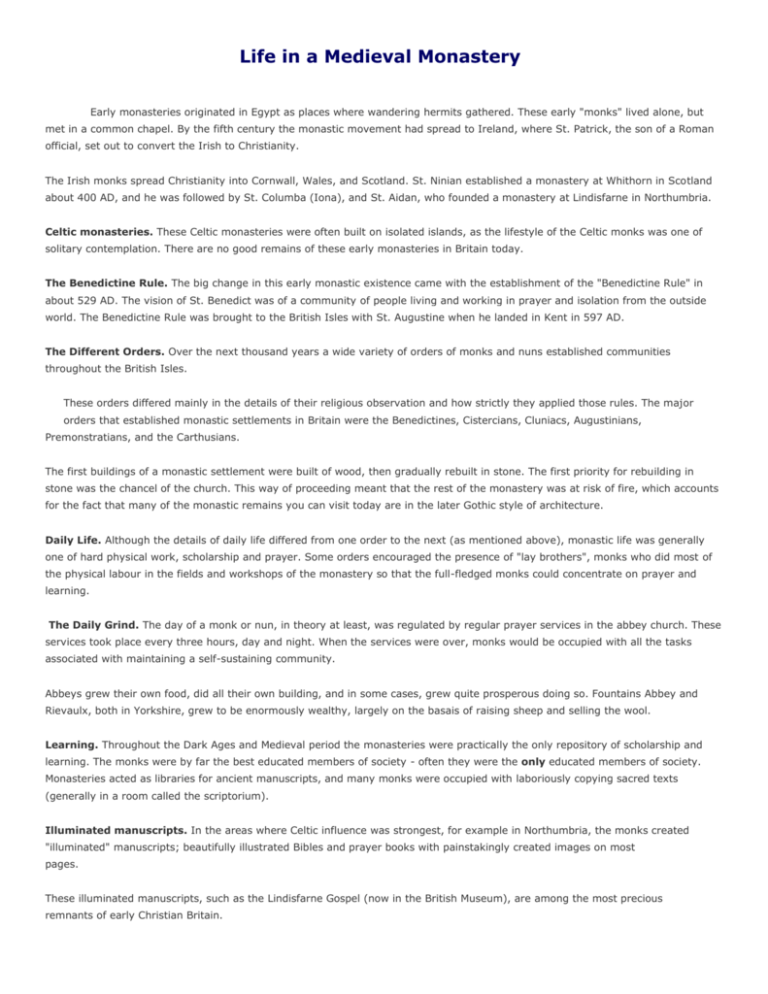
Life in a Medieval Monastery Early monasteries originated in Egypt as places where wandering hermits gathered. These early "monks" lived alone, but met in a common chapel. By the fifth century the monastic movement had spread to Ireland, where St. Patrick, the son of a Roman official, set out to convert the Irish to Christianity. The Irish monks spread Christianity into Cornwall, Wales, and Scotland. St. Ninian established a monastery at Whithorn in Scotland about 400 AD, and he was followed by St. Columba (Iona), and St. Aidan, who founded a monastery at Lindisfarne in Northumbria. Celtic monasteries. These Celtic monasteries were often built on isolated islands, as the lifestyle of the Celtic monks was one of solitary contemplation. There are no good remains of these early monasteries in Britain today. The Benedictine Rule. The big change in this early monastic existence came with the establishment of the "Benedictine Rule" in about 529 AD. The vision of St. Benedict was of a community of people living and working in prayer and isolation from the outside world. The Benedictine Rule was brought to the British Isles with St. Augustine when he landed in Kent in 597 AD. The Different Orders. Over the next thousand years a wide variety of orders of monks and nuns established communities throughout the British Isles. These orders differed mainly in the details of their religious observation and how strictly they applied those rules. The major orders that established monastic settlements in Britain were the Benedictines, Cistercians, Cluniacs, Augustinians, Premonstratians, and the Carthusians. The first buildings of a monastic settlement were built of wood, then gradually rebuilt in stone. The first priority for rebuilding in stone was the chancel of the church. This way of proceeding meant that the rest of the monastery was at risk of fire, which accounts for the fact that many of the monastic remains you can visit today are in the later Gothic style of architecture. Daily Life. Although the details of daily life differed from one order to the next (as mentioned above), monastic life was generally one of hard physical work, scholarship and prayer. Some orders encouraged the presence of "lay brothers", monks who did most of the physical labour in the fields and workshops of the monastery so that the full-fledged monks could concentrate on prayer and learning. The Daily Grind. The day of a monk or nun, in theory at least, was regulated by regular prayer services in the abbey church. These services took place every three hours, day and night. When the services were over, monks would be occupied with all the tasks associated with maintaining a self-sustaining community. Abbeys grew their own food, did all their own building, and in some cases, grew quite prosperous doing so. Fountains Abbey and Rievaulx, both in Yorkshire, grew to be enormously wealthy, largely on the basais of raising sheep and selling the wool. Learning. Throughout the Dark Ages and Medieval period the monasteries were practically the only repository of scholarship and learning. The monks were by far the best educated members of society - often they were the only educated members of society. Monasteries acted as libraries for ancient manuscripts, and many monks were occupied with laboriously copying sacred texts (generally in a room called the scriptorium). Illuminated manuscripts. In the areas where Celtic influence was strongest, for example in Northumbria, the monks created "illuminated" manuscripts; beautifully illustrated Bibles and prayer books with painstakingly created images on most pages. These illuminated manuscripts, such as the Lindisfarne Gospel (now in the British Museum), are among the most precious remnants of early Christian Britain. The Abbey hierarchy. The abbey (the term for a monastery or nunnery) was under the authority of an abbot or abbess. The abbot could be a landless noble, who used the church as a means of social advancement. Under the abbot was the prior/prioress, who ran the monastery in the absence of the abbot, who might have to travel on church business. There could also be a sub-prior. Other officers included the cellerar (in charge of food storage and preparation), and specialists in the care of the sick, building, farming, masonry, and education. Pilgrims. One of the main sources of revenue for monasteries throughout the medieval period were pilgrims. Pilgrims could be induced to come to a monastic house by a number of means, the most common being a religious relic owned by the abbey. Such a relic might be a saint's bone, the blood of Christ, a fragment of the cross, or other similar religious artefact. The tomb of a particularly saintly person could also become a target for pilgrimages. Pilgrims could generally be induced to buy an isignia which proved they had visited a particular shrine. Some popular pilgrimage centres built hotels to lodge pilgrims. The George Inn in Glastonbury is one such hotel, built to take the large number of pilgrims flocking to Glastonbury Abbey. Decline of the monasteries. Monasteries were most numerous in Britain during the early 14th century, when there were as many as 500 different houses. The Black Death of 1348 dealt the monasteries a major blow, decimating the number of monks and nuns, and most never fully recovered. The Medieval Monastery layout and buildings The principal buildings of a Benedictine monastery of the larger sort were grouped around an inner court, called a cloister. These included a church, a refectory, or dining room, with the kitchen and buttery near it, a dormitory, where the monks slept, and a chapter house, where they transacted business. There was also a library, a school, a hospital, and a guest house for the reception of strangers, besides barns, bakeries, laundries, workshops, and storerooms for provisions. Beyond these buildings lay vegetable gardens, orchards, grain fields, and often a mill, if the monastery was built on a stream. The high wall and ditch, usually surrounding a monastery, shut it off from outsiders and in time of danger protected it against attack. Uses of the Medieval monastery A Medieval monastery was a farm, an inn, a hospital, a school and a library. The uses of a Medieval monastery included the following: A Medieval monastery received pilgrims and travellers, at a period when western Europe was almost destitute of inns A Medieval monastery performed many works of charity, feeding the hungry, healing the sick who were brought to their doors, and distributing their medicines A Medieval monastery provided education for boys who wished to become priests and those who intended to lead active lives in the world A Medieval monastery copied the manuscripts of classical authors preserving valuable books that would otherwise have been lost A Medieval monastery kept records of the most striking events of their time and acted as chroniclers of the medieval history of the Middle Ages Monastic Orders Benedictines - founded by St. Benedict in 529 AD. The largest order, the Benedictines were noted for their learning. The four vows of these monks were to obedience,chastity, poverty, and manual labour for 7 hours each day. Carthusians - the Carthuisians lived lives of isolation and silence, spending their days in their own individual cells. The monks wore hair shirts and saw each other only on Sundays and feast days, but even then conversation was rarely allowed. The main Carthusian monastery in Britain was at Charterhouse in London. After the Dissolution of the Monasteries this became Charterhouse School. The Carthusians were too strict an order to win wide appeal. Cistercians - Begun in France under the influence of St.Bernard of Clairvaux, the order chose isolated rural locations to build their monasteries, particularly in Wales and in the north, where they reclaimed land laid waste by William the Conqueror. They were not so scholarly as the Benedictines, but focussed on agriculture and hard manual labour. Augustinians - founded in the 11th century, these "Black Canons" lived in communities but went out among the populace to preach. As a consequence of this, and their propensity for giving alms and hospitality, the Augustinians were quite popular, and their churches were thus large and ornate. Cluniacs - The Cluniacs were one of several orders who tried to return the Benedictine rule to its original simplicity. They first came to England at Lewes in about 1078. The Cluniacs spent much of their time in devotion, and left the agricultural toil to paid servants. Most Cluniac establishments were small; the largest were at Much Wenlock, Castle Acre, and Thetford Knights of the Temple (Templars) - founded in Jerusalem in 1118 for the expressed purpose of protecting (Christian) travellers to the Holy Land. The Templars became the "bankers of Christendom", and owned huge amounts of property throughout Europe. The order came to England under King Stephen, and the Temple Church in London is a good example of their habit of building round churches, or at least incorporating rounded shapes into their architecture. The order was officially disbanded in the early 14th century, though its legacy lives on in the many place names incorporating the word "temple". Knights of St. John of Jerusalem (Knights Hospitallars) - originally provided hospitality and medical care to pilgrims in the Holy Land. The Hospitallers came to England under Henry I. They founded houses where novices could be trained in military arts and receive religious instruction. When the Templars were disbanded the Hospitallers recieved many of their churches and other property.
